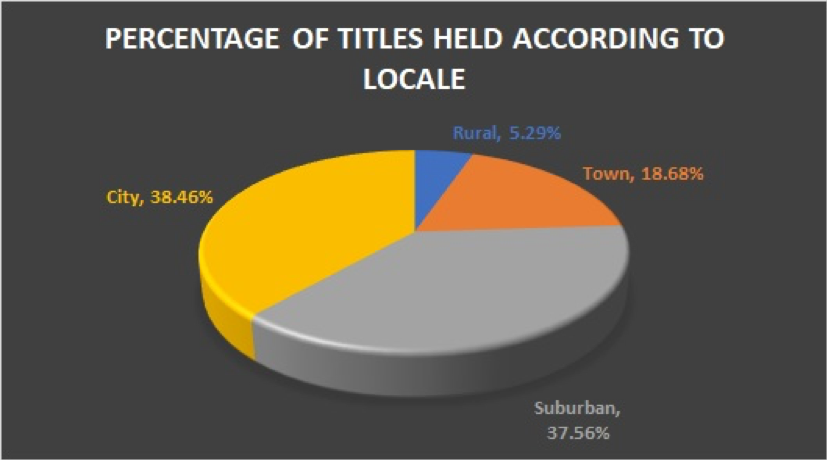
Researching the Distribution of Hispanic and Latino Children’s Books in United States Public Libraries
I worked with a team that researched the distribution of Hispanic and Latino children’s books in various US libraries, and we compared our findings with population statistics to glean insights. This report is a summary of our findings. This was originally written for my Introduction to Research in Library and Information Science class in the Fall of 2017.
Summary of Results
The purpose of this study was to determine whether high-quality children’s materials featuring Hispanic/Latino themes are available in U.S. public libraries. The study examined both community and library variables to determine the influences on the availability of these types of titles. The results of this study indicate that the majority of U.S. public libraries have at least half of these materials available. The library variables studied were the location of the library and the number of librarians that hold Masters in Library and Information Science (MLIS) degrees per library. The community variable studied was the percentage of Hispanic people within the population of the area where the library is located. This study found that the library variables had a stronger correlation with the number of titles held than the community variable.
One hundred four public libraries in the United States were analyzed to determine how many titles their collection included from a list of 16 recently published Pura Belpré Award winners or honor books. Table 1 shows a summary of the results of this analysis. The mean number of titles held by each library is 10 of the 16 titles searched. Only 2% of the libraries held all 16 titles and another 2% did not carry any of the titles. Seventy-one percent of libraries had eight or more of the titles searched, while 29% had seven or fewer. Each of the 16 titles was held by an average of 63 libraries.
Table 1.
| Number of Titles | Number of Libraries | Percentage of Libraries |
|---|---|---|
| 0 | 2 | 1.92% |
| 1 | 1 | 0.96% |
| 2 | 3 | 2.88% |
| 3 | 0 | 0.00% |
| 4 | 6 | 5.77% |
| 5 | 6 | 5.77% |
| 6 | 9 | 8.65% |
| 7 | 6 | 5.77% |
| 8 | 8 | 7.69% |
| 9 | 7 | 6.73% |
| 10 | 8 | 7.69% |
| 11 | 8 | 7.69% |
| 12 | 5 | 4.81% |
| 13 | 13 | 12.50% |
| 14 | 12 | 11.54% |
| 15 | 8 | 7.69% |
| 16 | 2 | 1.92% |
| Total | 104 | 100% |
The percentage of Hispanic residents in the county where the library is located was examined to determine if there was a correlation between the number of titles with Hispanic/Latino themes that each library holds and the size of the Hispanic population. The libraries were divided into quartiles consisting of 26 libraries each. The quartiles were analyzed to find the average Hispanic population, the number of titles held by each quartile, and the percentage of all titles held by each quartile. The data do not suggest a strong correlation between Hispanic population and the number of titles held, especially when compared to the other variables studied. Figure 1 summarizes this data. Quartile 4 represents the libraries with the smallest Hispanic population with an average of 1.84% of the library’s total population, while Quartile 1 represents the libraries with the largest Hispanic population with an average of 36.76%. Quartiles 2 and 3 have average Hispanic populations of 12.69% and 4.95%, respectively. The number of titles held by each quartile ranges from 226 titles held by libraries in Quartile 4 to 281 titles in Quartile 1. Quartiles 2 and 3 both hold 247 titles, despite a fairly large difference in their average Hispanic populations. While Quartile 1 does hold the highest average percentage of all titles and have the largest percentage of Hispanic residents among the population of the libraries, the range of the number of titles held is so narrow across the quartiles, despite the differences in Hispanic population size, that a correlation between the two variables appears nonexistent or negligible.
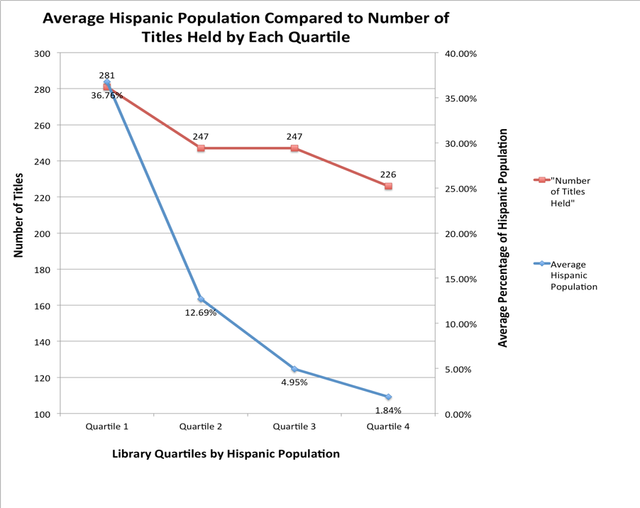
The next variable studied was the number of librarians in each library who hold a postgraduate degree in Library Science. The libraries were once again sorted into quartiles based on this data. The number of librarians with a MLIS degrees was calculated for each quartile and then compared to the number of titles held and the percentage of all titles held by that quartile. The data are summarized in Figure 2. The data show a positive correlation between the number of librarians holding MLIS degrees and the number of children’s materials containing Hispanic/Latino themes. Quartile 1 represents the libraries with the highest number of librarians holding MLIS degrees, at 18.54. This quartile holds 316 titles, representing 31.57% of all titles held. Quartile 2 has the second highest number of librarians with MLIS degrees at 10.23. This quartile holds 294 titles, or 29.37%. Quartile 3 has an average of 5.06 librarians holding MLIS degrees and has 214 titles, or 21.38%. Only 1.42 librarians in Quartile 4 have MLIS degrees. This quartile holds the lowest number of titles: 177, or 17.68%, of all titles. The number of Pura Belpré titles held by the libraries in each quartile declines steeply as the number of librarians holding Library Science degrees declines. The consistency in the degree of decline for both variables indicates that there is a positive correlation between libraries staffed by those with MLIS degrees and the availability of books with strong Hispanic themes and representation.
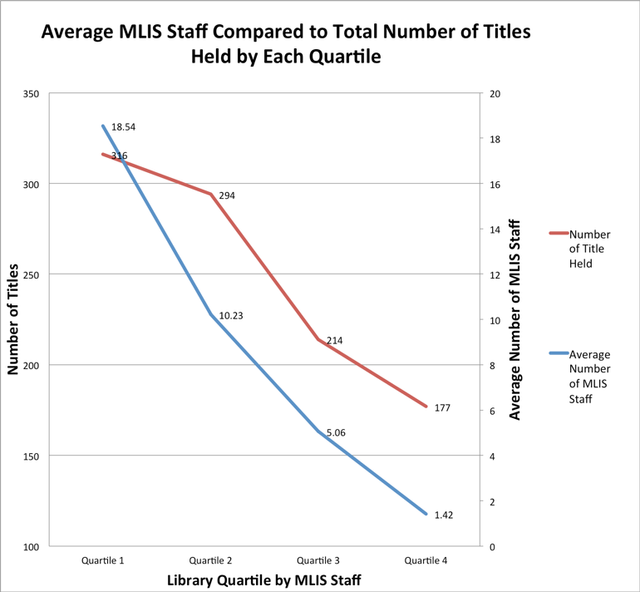
The libraries in the sample were sorted and grouped by one of four location types: cities, suburban areas, towns, and rural areas. This resulted in unequal groupings, with the majority of libraries being located in cities or suburban areas. Ten libraries were located in rural areas, 21 in towns, 36 in suburban areas, and 37 in cities. The groups were examined to determine the total number of titles held in each group and the percentage of all titles held. This data is summarized in Figure 3. Rural libraries hold the lowest percentage of the titles at 5.29%. Towns hold the second lowest percentage of the titles at 18.68%. Suburban libraries hold 37.56% of the titles. Cities hold the highest number of titles with 38.46%. The data suggest that cities and suburbs are much more likely to carry children’s literature with Hispanic and Latino themes than towns and rural areas. These figures are somewhat misleading, however, due to the higher number of city and suburban libraries in the sample. The average number of titles held by each library within each group was also calculated in an effort to compensate for the unequal groupings. The percentage of all titles held was recalculated using these averages. The results of these adjustments are summarized in Figure 4. While rural and town libraries still had fewer holdings, the differences were significantly less, with an average of 15.12% of the titles held per library in rural areas and 25.4% in towns. Suburban libraries had an average of 29.79% of all titles per library and libraries within cities had an average of 29.68%.
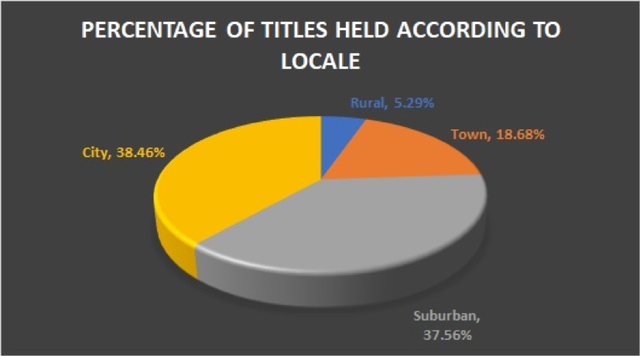
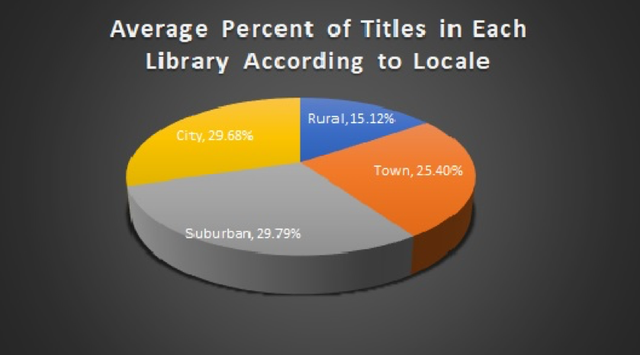
Limitations
There were several limitations with this study. The study relied on data gathered from the online library catalogs. Availability within the catalog does not guarantee that the material will be found within the library. Likewise, only items that each library had within their collections were counted. However, many of the libraries were part of a consortium and could provide the materials to patrons even though they might not hold copies in their own collections. In addition, the number of titles searched were limited to only 16 titles. A more extensive search for Hispanic-themed materials may provide a complete picture of the materials available to Hispanic patrons. The study was also limited to the availability of books and neglected to examine other types of materials or services that may serve the needs of this population. Finally, when the libraries in this study were sorted by locale, the resulting groups contained unequal numbers. While the data was manipulated in an attempt to compensate for this, equal groups of libraries by locale could produce more reliable data.
Conclusions
There are several conclusions that can be drawn from this study. First, the size of the Hispanic population of an area does not appear to correlate with the number of Pura Belpré Award and honoree books a library holds. This is surprising, given the well-known adage that demand should inform supply, therefore it does not seem unreasonable to assume that the demands of large Hispanic populations would result in a library with a large supply of Hispanic and Latino children’s literature. One of the factors that might be affecting this result is the small list of specific titles. Only 16 titles were chosen, all of recent publication and recognized by the same award. A more comprehensive search of Hispanic/Latino themed materials, as well as Spanish language materials, could potentially reveal very different results. Future researchers could conduct a more thorough search of these kinds of materials, and may even want to extend their research beyond books to library programs and services aimed at the Hispanic population, in order to determine whether the needs of this population are being met. Any materials and services specifically intended to serve the Hispanic and Latino population could be evaluated for quality in an effort to guarantee that libraries are providing for Hispanic patrons’ needs. Libraries with higher Hispanic populations should make a concentrated effort to regularly add high-quality materials featuring Hispanic/Latino themes to their collections.
The second conclusion drawn from this data is that the number of librarians that hold Master’s degrees in Library Science has a positive correlation with the number of Hispanic/Latino themed materials held by the library. One possible explanation for this is that librarians that hold MLIS degrees are more likely to develop collections that represent a variety of cultural viewpoints. The results of this study suggest that public libraries interested in expanding the diversity of their collections and providing for the needs of diverse patrons should invest in hiring MLIS-credentialed librarians.
Third, the data show a positive correlation between public libraries located in more highly populated areas and the number of materials with Hispanic/Latino themes in the collection. One possible explanation for this is that more financial resources are available to libraries in more highly populated areas, and this funding could be used both to expand the collection and to hire librarians with degrees who may suggest or direct any collection-expansion efforts. Future research could examine annual collections budgets to determine if there is a correlation between the budget numbers and number of Hispanic/Latino titles held. In an effort to better meet the needs of Hispanic patrons, libraries with limited materials should take advantage of grants that would help include needed titles to represent Hispanic/Latino themes. Another explanation is that there is simply more demand for these materials in more densely-populated areas. An examination of census records could be used to determine how density of population correlates to ethnic and cultural diversity, and thus in turn how the population density of an area correlates to the need for diverse library materials.
This study has shown positive correlations between both population density and number of MLIS-degree librarians, and the number of high-quality books with Hispanic and Latino themes held by each library, and has revealed little or no correlation between a high percentage of Hispanic patrons and the number of Hispanic-themed books in the library. This study did not include research into several factors that could affect these results, but the data are sound and it is believed these results are accurate and repeatable within the frame of the study.